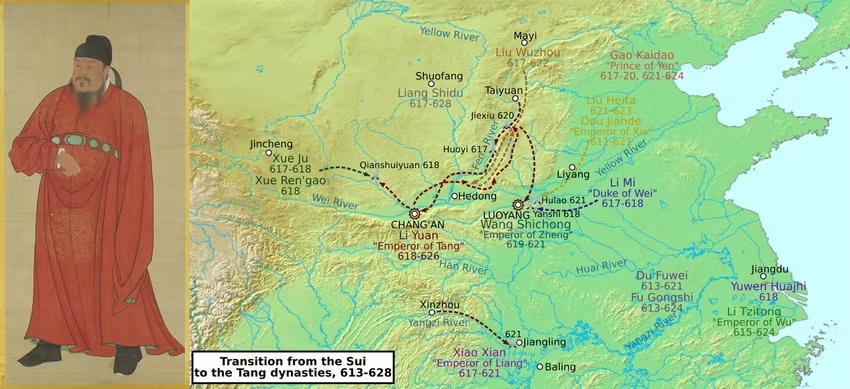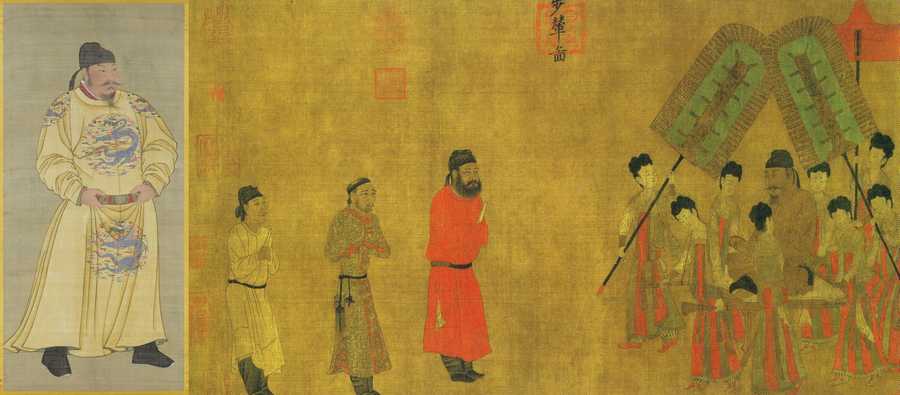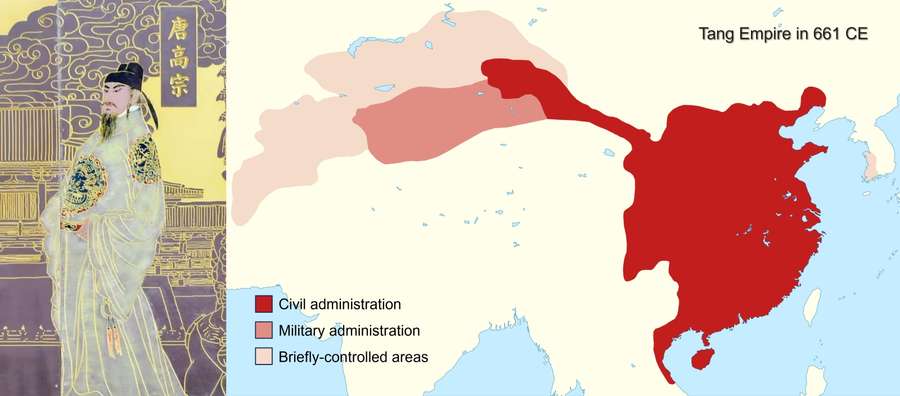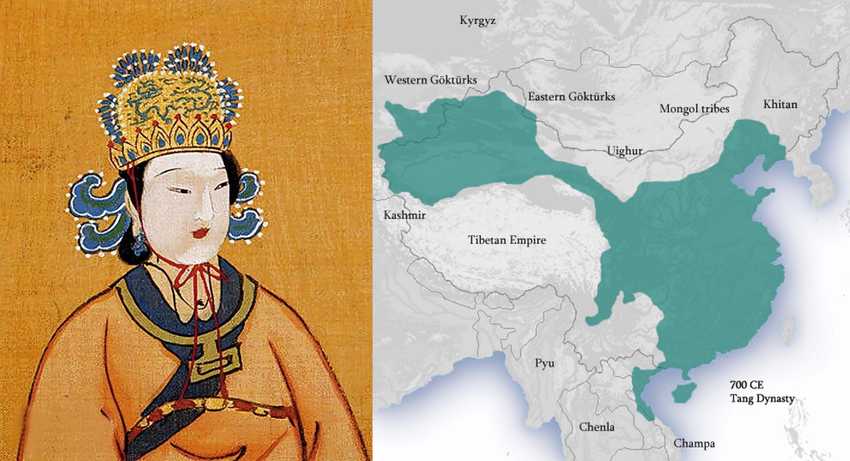Chinese Dynasty: Tang Dynasty’s Epic Rise to Glory
The Tang Dynasty (唐朝, Táng, 618-907 CE) was a unified and influential dynasty in Chinese history that lasted for 289 years. It was a prominent imperial ruling dynasty succeeding the Sui Dynasty (隋朝) and was succeeded by the Five Dynasties and Ten Kingdoms period (五代十国).
Historians widely recognize the Tang Dynasty as a pinnacle of Chinese civilization, representing a golden age of cosmopolitan culture and remarkable achievements. It saw a flourishing of arts, sciences, and trade, establishing itself as a central authority in East Asia and attracting influence from neighboring civilizations.
In this series, we will conduct an in-depth exploration of the history and influence of the Tang Dynasty, dividing it into three separate articles. This first article will primarily focus on the history of Tang from its establishment to the Wu Zhou era (武周).
Rise, Establishment, and Unification

Left: a portrait of Emperor Gaozu of Tang.
Right: map of northern China during the transition from Sui to Tang, with the main contenders for the throne and the main military operations, 613-628 CE.
The Tang Dynasty's imperial clan, the Li family (李氏), rose up by the key figure Li Hu (李虎) during the Northern and Southern Dynasties period (南北朝). Li Hu aligned himself with the powerful Yuwen Tai (宇文泰) of Northern Wei (北魏), becoming one of the Yuwen family's key supporters. After Li Hu's death, his son Li Bing (李昞) continued to gain prominence during the Western Wei (西魏) and Northern Zhou (北周) reigns. He was recognized as an important figure and received the Xianbei surname Daye (大野氏). He regained his original surname Li under the rule of Yang Jian (杨坚), Emperor Wen of Sui (隋文帝). Li Bing's son, Li Yuan (李渊), succeeded as the Duke of Tang (唐国公) at a young age and married Dou (窦氏), the granddaughter of Yuwen Tai. He earned favor from Yang Jian and Empress Dugu (皇后独孤氏) and held the position of military governor in Taiyuan (太原) during the Sui Dynasty.
During the reign of Emperor Yang of Sui (隋炀帝, 605-618 CE), due to the abuse of national resources and repeated failures in campaigns against Goguryeo (高句丽), the empire faced multiple rebellions. Li Yuan saw the widespread chaos and the irreversible decline of Sui and conceived the idea of replacing it. In May 617, Li Yuan raised an army in the name of honoring Sui and swiftly advanced, occupying Chang'an (长安, present-day Xi'an) in November. He proclaimed Yang You (杨侑) as the new emperor, known as the Emperor Gong of Sui (隋恭帝). Li Yuan was enfeoffed as the King of Tang (唐王).
In March 618, Emperor Yang passed away, and in May, Yang You abdicated in favor of Li Yuan, who then declared himself emperor, establishing the Tang Dynasty (唐朝), with Chang'an as its capital, marking the end of the Sui Dynasty (隋朝). Li Yuan is posthumously known as the Emperor Gaozu of Tang (唐高祖). Subsequently, Emperor Gaozu appointed his eldest son, Li Jiancheng (李建成), as the Crown Prince (太子), his second son, Li Shimin (李世民), as the King of Qin (秦王), and his fourth son, Li Yuanji (李元吉), as the King of Qi (齐王).
During the early period of the Tang Dynasty, China had been suffering from prolonged wars, resulting in severe economic damage and a significant decline in population. The northern border was also threatened by the powerful Eastern Turkic tribes (东突厥).
Various political forces continued to contend for power after the establishment of Tang. Emperor Gaozu based himself in Guanzhong (关中), gradually consolidating his strength. Through military campaigns and strategic maneuvers, the Tang forces quickly expanded their control over various regions. By 621 CE, the Tang had unified most of Henan (河南), Hebei (河北), and Shandong (山东). In the following years, the Tang forces pacified other areas such as Jiangling (江陵), Lingnan (岭南), and Jianghuai (江淮), successfully suppressing rebellions and consolidating their rule over the whole nation by 628 CE.
During Emperor Gaozu's reign (618-626 CE), he reformed oppressive Sui policies, established laws, governmental systems, schools, and a military structure, and introduced economic reforms like the equal-field system (均田制) and tax policies. These reforms laid the foundation for the subsequent development of the Tang Dynasty.
Reign of Zhenguan (贞观之治)

Left: a portrait of Emperor Taizong of Tang.
Right: Emperor Taizong depicted giving an audience to Gar Tongtsen Yulsung, the ambassador of the Tibetan Empire, a copy of a painting by Yan Liben.
During the founding of Tang, Emperor Gaozu's two sons, Li Jiancheng (李建成) and Li Shimin (李世民), played significant roles. Though Li Jiancheng, who was the Crown Prince, made contributions, Li Shimin's military achievements were more notable, and some historians believe that Tang's success in the unification of China was largely due to Li Shimin's efforts. As Li Shimin's influence grew, conflicts with his brothers intensified, and Emperor Gaozu's indecisiveness exacerbated the rivalry.
In June 626, Li Shimin launched a military coup at Xuanwu Gate (玄武门), assassinating Li Jiancheng and their younger brother, Li Yuanji (李元吉). After this incident, Emperor Gaozu was forced to appoint Li Shimin as the Crown Prince. In August, Emperor Gaozu abdicated, and Li Shimin ascended the throne as the Emperor Taizong of Tang (唐太宗).
Emperor Taizong was a wise ruler, known for learning from historical lessons and having a farsighted political vision. He emphasized the importance of people's well-being, selected talented officials and improved the imperial examination system (科举制度) from the Sui Dynasty, welcomed advice, and implemented various reforms for social stability and economic development.
Emperor Taizong also dealt with external threats by defeating various tribes and kingdoms, maintaining a relatively equal and tolerant attitude toward minority groups. He was highly respected by neighboring nations, being referred to as the Heavenly Khan (天可汗).
Under his rule, the Tang Dynasty experienced a prosperous period known as the Reign of Zhenguan (贞观之治, 627-649 CE), marked by political clarity, economic growth, and military successes.
However, in the later years of Emperor Taizong's rule, he became increasingly arrogant and imposed heavier burdens on the people. He also faced a succession crisis concerning his sons.
Li Chengqian (李承乾), his eldest son, was initially the Crown Prince. But Li Tai (李泰), his fourth son, gained favor and posed a threat to Li Chengqian's position. This rivalry caused turmoil within the court, leading to a rebellion by Li Chengqian in 643 CE. After considering the situation, Emperor Taizong deposed both Li Chengqian and Li Tai and instead appointed his gentle-natured son, Li Zhi (李治), as the new Crown Prince, who later became the Emperor Gaozong of Tang (唐高宗).
Reign of Yonghui (永徽之治)

Left: Emperor Gaozong on the murals of Famen Temple.
Right: Tang Empire in 661 CE, when it reached its greatest extent.
In 649 CE, Emperor Taizong passed away, and Li Zhi succeeded the throne as Emperor Gaozong (唐高宗). In 653, Emperor Gaozong consolidated his rule by suppressing the opposition, including factions of the imperial family and nobles, in a rebellion case. In 655, He replaced the noble-born Empress Wang with Empress Wu (i.e., Wu Zetian, 武则天) and used the opportunity to remove influential officials like Zhangsun Wuji (长孙无忌) and Chu Suiliang (褚遂良). This struggle aimed to break the dominance of aristocratic groups in the government and weaken their influence.
As Emperor Gaozong came to power, he welcomed the opinions of his ministers, addressed the concerns of the people, and continued the good governance policies of his father, Emperor Taizong. This period was known as the Reign of Yonghui (永徽之治, 649-655 CE), characterized by political stability, economic prosperity, and implementation of the laws from the Zhenguan era.
During this period, the population of Tang grew from less than three million households during the Zhenguan era to 3.8 million households.
While focusing on internal governance, Emperor Gaozong continued Tang's expansion and military campaigns. In 650 CE, General Gao Kan (高侃) captured the Eastern Turkic ruler and Emperor Gaozong divided the territories into Chanyu (单于) and Hanhai (瀚海) Protectorates. He also waged wars against the Western Turkic Khanate (西突厥) and successfully conquered them in 657 CE. He established Kunling (昆陵) and Mengchi (蒙池) Protectorates in the former Western Turkic Khanate territories and moved the Anxi Protectorate (安西都护府) to Kucha (now in Xinjiang, China).
In 655 CE, Goguryeo (高丽) and Baekje (百济) launched an attack on Silla (新罗), and Silla sought Tang's help. Emperor Gaozong sent troops to counter the invasion from Goguryeo and Baekje. In 663 CE, Tang forces achieved a major victory over the combined forces of Baekje and Wa (倭国, now Japan), leading to the collapse of Baekje. In 668 CE, Tang forces captured Pyongyang (平壤), leading to the downfall of Goguryeo. Emperor Gaozong established the Andong Protectorate (安东都护府) and divided the conquered territories into forty-two prefectures.
During Emperor Gaozong's reign, Tang's territory expanded to its widest extent, covering regions from the Korean Peninsula in the east, the Aral Sea (咸海, or possibly the Caspian Sea, 里海) in the west, Lake Baikal (贝加尔湖) in the north, and the Hoành Sơn Range (越南横山) in the south. This territorial map was maintained for over thirty years.
Empress Wu Zetian (武则天)

Left: a portrait of Empress Wu Zetian. Right: Wu Zhou in 700 CE.
Rose in Power
During the reign of Emperor Gaozong (唐高宗), Empress Wu, commonly known as Wu Zetian (武则天), gradually became involved in politics. Wu Zetian was originally a consort of Emperor Taizong (唐太宗), but after his death, she became a Buddhist nun. Later, Emperor Gaozong, Emperor Taizong's son, summoned her back to the palace as a consort, and she won in power struggles, eventually becoming the empress. In 660 CE, due to Emperor Gaozong's health issues, Wu Zetian began assisting in handling state affairs.
In 683 CE, Emperor Gaozong passed away, and Crown Prince Li Xian (李显) succeeded him, becoming Emperor Zhongzong of Tang (唐中宗). Wu Zetian ruled in the name of Empress Dowager. However, in 684, due to conflicts with Emperor Zhongzong, she deposed him and replaced him with her fourth son, Li Dan (李旦), who became Emperor Ruizong of Tang (唐睿宗).
Wu Zetian's Rule
In the following years, there were several uprisings, but Wu Zetian sent troops and suppressed them. These rebellions directly led to her purging the Tang imperial family's ministers and paved the way for her to proclaim herself Emperor in 690 CE. She changed the country's name to Zhou (周) with Luoyang as its capital. This brief dynasty is referred to as Wu Zhou (武周) in history, which lasted from 690 to 705 CE. She was the first and only Empress Regnant in Chinese history.
During her reign as Empress Dowager, Wu Zetian had already proposed policy recommendations including promoting agriculture, reducing taxes and corvée labor, stopping military campaigns, elevating capable officials regardless of their background, and allowing freedom of speech. These measures promoted economic development, and the population under state control increased from 3.8 million households during the early Yonghui era to 6.5 million households.
Wu Zetian had the ability to control her subordinates. She encouraged scholars to recommend themselves, instituted examinations for palace and military officials, and appointed officials who demonstrated talent. While she had excessive recruitment and rapid promotions, she would immediately demote those found incompetent. Her wide involvement of non-aristocratic classes in politics expanded the political base of the ruling class and restrained the influence of aristocrats, contributing to the consolidation and development of her regime.
During her reign as the Empress Regnant, Wu Zetian restructured the military with the establishment of Four Garrisons of Anxi (安西四镇) to pacify Western Turkic Khaganate (西突厥). She also resisted invasions from the Second Turkic Khaganate (后突厥) and dealt with rebellions from the Khitans (契丹) in the northeast. These measures contributed to the unification and development of the multi-ethnic state.
Wu Zetian's rule also saw progress in social, cultural, and artistic aspects. Buddhism flourished during this period, and many Buddhist temples were constructed or expanded, with the Longmen Grottoes (龙门石窟) being a prominent example.
However, the darkest aspects of her rule were her acceptance of accusations and the appointment of cruel officials. She set up bronze boxes in the court to accept anonymous denunciations, leading to a culture of widespread informing. She also appointed cruel officials who fabricated charges against high-ranking officials, leading to the execution of hundreds of Tang royalty and ministers. This extreme and terrifying political atmosphere only ceased after she proclaimed herself Empress Regnant and her regime stabilized. Towards the end of her rule, she became increasingly extravagant and dictatorial, leading to corruption and misgovernance.
Under internal and external pressure, Wu Zetian was forced to recall Li Xian (李显) from exile and reinstate him as Crown Prince. In 705 CE, the Shenlong Coup (神龙政变) forced Wu Zetian to abdicate and restore Li Xian as Emperor Zhongzong (唐中宗), reverting from Wu Zhou back to the Tang Dynasty. A few months later, Wu Zetian passed away
Read More
History of the Tang Dynasty from restoration after Wu Zhou to the end
Astounding achievements and lasting legacy of the Tang Dynasty